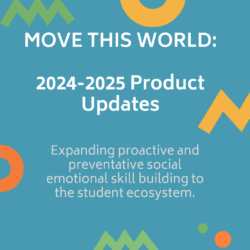Many districts are exploring the option of staggered schedules or partial reporting. Staggered schedules would ask specific grades to report on certain days to limit the number of students in the building at one time. Another option districts are exploring includes continuing remote learning for secondary students in order to use the extra school space for primary grades. Some schools are providing parents with the option to send students to school or keep them home, while other schools plan to limit travel around campus by keeping students in the same classroom all day. There are a lot of options for next year that include students learning both at home and back in the classroom. Download our SEL Toolkit: Planning for Reentry.
Social emotional learning in a partial reopening model requires support for both students and families. With new schedules to keep track of or a new school building to learn, students will be presented with new challenges. SEL can help students adapt to their new environments and manage new expectations, while also fostering a sense of belonging.
Here are 3 considerations for SEL in a partial reopening:
1. Use the valuable in-person time you have with students for things that will be more difficult to accomplish via remote learning.
When students are on campus, use the time together for meaningful relationship building, social connection and small group instruction, both academic and SEL focused. You can then reinforce what was prioritized in person via online or remote learning more easily.
A flipped classroom model may be beneficial for teachers and students. The concept is based on “flipping” the idea that instruction happens at school and practice happens at home. Instead, in a flipped classroom model, students prepare to learn new concepts at home through independent reading, videos, or activities that introduce them to new topics. This allows teachers to spend more time providing support as students apply new skills and concepts, instead of spending time explicitly teaching and leaving students to practice on their own.
2. Provide frequent opportunities for reflection and feedback to identify needs as students adapt to a new environment.
Students and families may need additional support as they adjust to a new partial reopening learning model. Regular communication with students and families can help schools stay updated on the challenges that a partial reopening may present to adjust and better support the needs of students and their families. Weekly check-ins are one way to receive regular feedback from students and families. Coordinate a team of educators to evaluate the data each week and identify areas for improvement.
3. Provide support for families to continue to facilitate SEL at home.
Parents are likely juggling their own changing schedules as they continue to work from home or start returning to the workplace. Keeping up with a learning schedule isn’t always easy, and life at home may be more stressful as the family adjusts to the new school year. Provide social emotional learning opportunities for families to reflect and connect with themselves and each other. You can find free SEL resources for families in our COVID-19 Resource Library, or check out 10 Ways Parents Can Bring Social Emotional Learning Home for EdSurge from our Founder & CEO, Sara Potler LaHayne.
Download our SEL Toolkit: Planning for Reentry to find more considerations for SEL in a partial reopening, including printable resources.
A partial reopening may feel overwhelming to many teachers, who now feel like they have to plan for both in-person classes and remote learning. Organize systems of support for your staff to care for their social and emotional wellbeing, too. Create a dedicated time in the day for all students to practice SEL together and build community, whether in person or at home. At school, social emotional learning should include opportunities to build connections with their peers. At home, SEL can provide opportunities for personal reflection or building connections with family and friends.
Video-based social emotional learning programs like Move This World can provide continuity of practice no matter where students are learning. Learn more about how Move This World works here. Or, complete the form below for more information about implementing Move This World in a partial reopening.
[pardot-form id=”2500″ title=”Resource Download_Implementing MTW_Blended”]










